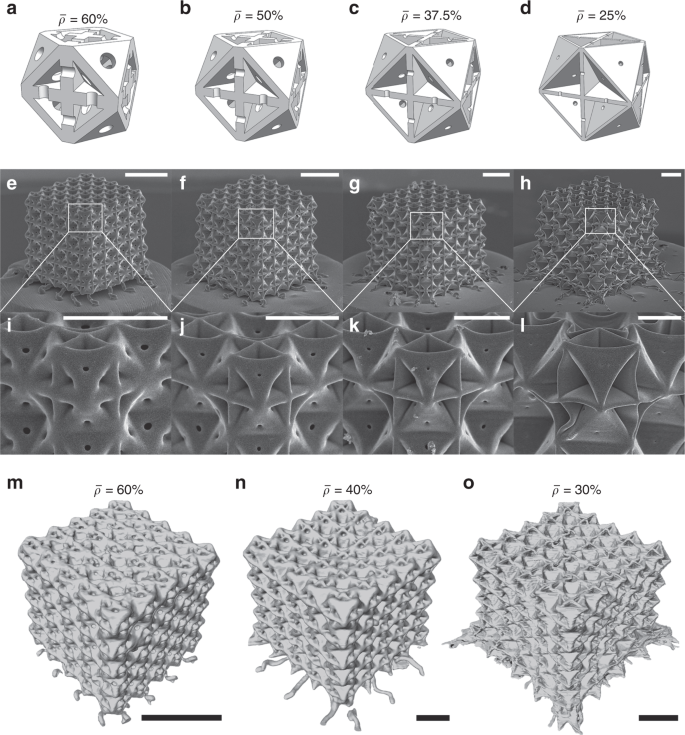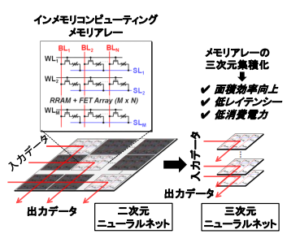(UCI-led team designs carbon nanostructure stronger than diamonds)
2020/4/13 カリフォルニア大学校アーバイン校(UCI)

・ UCI、カリフォルニア大学サンタバーバラ校(UC Santa Barbara)およびドイツ・マルティン・ルター大学ハレ・ヴィッテンベルクによる研究チームが、ダイヤモンドを超える比強度を有するプレートナノ格子構造体を開発。
・ ナノメートルサイズの炭素構造体である同プレートナノ格子は、従来の円筒状のトラスに代わり、密接する閉じたセルのプレートより構成。走査型電子顕微鏡(SEM)等による調査で、従来構造に比して機械強度が最高 639%、硬度が 522%と飛躍的な向上を確認した。
・ プレートベースの設計によるナノ格子では、強度の飛躍的な向上が予想されていたが、その作製が困難なことから証明が不可能であった。今回、二光子重合ダイレクトレーザーライティング(TPP-DLW)と呼ばれる複合的な 3D レーザープリンティングプロセスにより、同構造の作製に成功。
・ 同プリンティングプロセスでは、UV 光感応性の液体樹脂の液滴内部にレーザーを集束させると、2個の光子が同時に分子に衝突して固体ポリマーを形成する。レーザーの走査により、160nm の薄さのプレートの集合から成るセルの規則的な配置が可能になる。
・ 同プロセスの最終段階では、ナノ格子を真空にて 900℃で一時間加熱。これにより、多孔質ながら最高強度を提供する、ガラス質の炭素の立方形の格子構造が完成する。
・ 余剰な樹脂を除去するために各プレートに持たせた微細孔が、同プロセスの革新性の一つ。本研究ではまた、ベースとなる物質が有する固有の機械的効果の活用も達成。100nm まで微細化した物質は孔や亀裂の無い理論的な結晶構造となる。これらの欠陥の低減により、構造体全体の強度が向上した。
・ ナノ格子構造体では、その高い強度と低い質量密度が航空機や航宙機の性能に貢献すると考えられ、特に航空宇宙分野での構造工学において期待されている。
・ 本研究には、米海軍研究局(ONR)とドイツ研究振興協会(DFG)が資金を提供した。
URL: https://news.uci.edu/2020/04/13/uci-led-team-designs-carbon-nanostructure-strongerthan-diamonds/
<NEDO海外技術情報より>
(関連情報)
Nature Communications(フルテキスト)
Plate-nanolattices at the theoretical limit of stiffness and strength
URL: https://www.nature.com/articles/s41467-020-15434-2
Abstract
Though beam-based lattices have dominated mechanical metamaterials for the past two decades, low structural efficiency limits their performance to fractions of the Hashin-Shtrikman and Suquet upper bounds, i.e. the theoretical stiffness and strength limits of any isotropic cellular topology, respectively. While plate-based designs are predicted to reach the upper bounds, experimental verification has remained elusive due to significant manufacturing challenges. Here, we present a new class of nanolattices, constructed from closed-cell plate-architectures. Carbon plate-nanolattices are fabricated via two-photon lithography and pyrolysis and shown to reach the Hashin-Shtrikman and Suquet upper bounds, via in situ mechanical compression, nano-computed tomography and micro-Raman spectroscopy. Demonstrating specific strengths surpassing those of bulk diamond and average performance improvements up to 639% over the best beam-nanolattices, this study provides detailed experimental evidence of plate architectures as a superior mechanical metamaterial topology.


